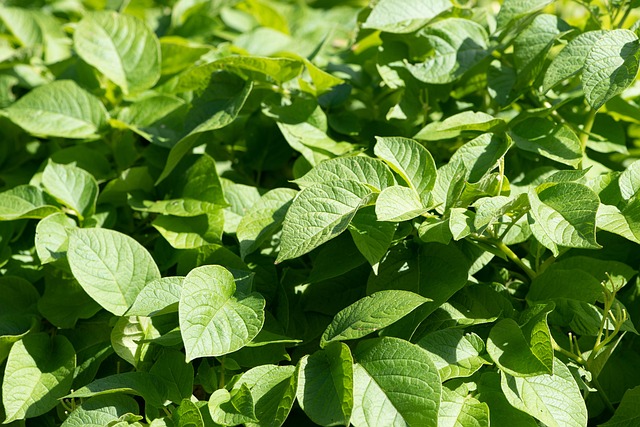White spots on potato leaves can be a cause of concern for gardeners and farmers alike. These spots can be caused by a variety of factors, including diseases, pests, and environmental stressors. Understanding the cause of white spots on potato leaves is crucial for preventing and treating the issue.
Common diseases of potato plants that can cause white spots on leaves include early blight, late blight, and powdery mildew. These diseases can cause white or gray spots on the leaves, which can eventually turn yellow or brown and cause the leaves to wither and die.
Pests such as spider mites, aphids, and thrips can also cause white spots on potato leaves by feeding on the leaves and leaving behind small white or yellow dots.
Prevention and treatment of white spots on potato leaves depend on the cause of the issue. Proper plant care, including regular watering, fertilization, and pruning, can help prevent the development of diseases and pests.
If white spots do appear on the leaves, it is important to identify the cause and treat it accordingly, whether through the use of fungicides, insecticides, or other methods.
Key Takeaways
- White spots on potato leaves can be caused by diseases, pests, and environmental stressors.
- Common diseases that cause white spots include early blight, late blight, and powdery mildew.
- Prevention and treatment of white spots depend on the cause, and may involve proper plant care, chemical treatments, or other methods.
Also see:
Understanding White Spots on Potato Leaves
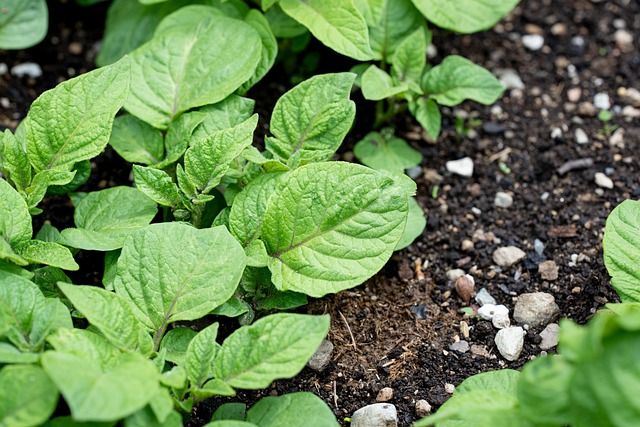
Potato plants are susceptible to a variety of diseases and pests that can cause damage to the leaves. One of the most common issues that potato growers face is the appearance of white spots on the leaves. In this section, we’ll take a closer look at white spots on potato leaves, how to identify them, and what causes them.
Identifying White Spots
White spots on potato leaves can vary in appearance, depending on the underlying cause. In general, they appear as small, white or yellowish spots that may be raised or flat. These spots can be found on both the upper and lower surfaces of the leaves.
One common cause of white spots on potato leaves is early blight, a fungal disease that affects potato plants. Early blight typically starts as small, dark spots on the leaves that gradually enlarge and turn white in the center.
Another possible cause of white spots on potato leaves is late blight, another fungal disease that affects potato plants. Late blight can cause large, irregular-shaped white spots on the leaves, often accompanied by a foul odor.
Causes of White Spots
White spots on potato leaves can be caused by a variety of factors, including fungal diseases, bacterial infections, and environmental stressors. In addition to early and late blight, other fungal diseases that can cause white spots on potato leaves include powdery mildew and white mold.
Bacterial infections can also cause white spots on potato leaves. One common bacterial disease that affects potato plants is blackleg, which can cause white spots on the leaves as well as blackened stems and tubers.
Environmental stressors such as excessive heat, drought, or nutrient deficiencies can also cause white spots on potato leaves.
Common Diseases of Potato Plants
Potatoes are susceptible to various diseases that can affect their growth, yield, and quality. Here are some of the most common diseases of potato plants:
1. Early Blight
Early blight is a fungal disease caused by Alternaria solani. It affects the leaves, stems, and tubers of potato plants. The symptoms of early blight include dark brown lesions with concentric rings on the leaves, which eventually turn yellow and drop off.
The disease can also cause stem cankers and sunken lesions on the tubers, making them susceptible to secondary infections. Early blight can be controlled by crop rotation, fungicide applications, and proper plant spacing.
2. Late Blight
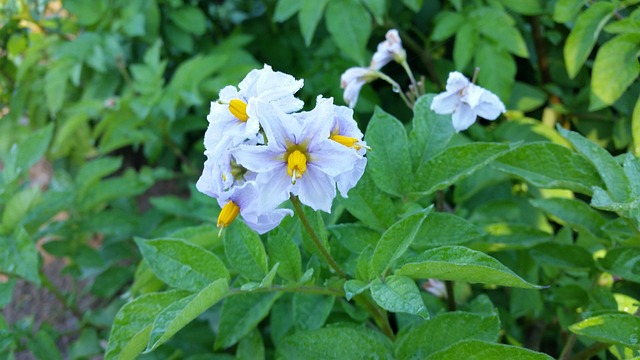
Late blight is a devastating fungal disease caused by Phytophthora infestans. It affects the leaves, stems, and tubers of potato plants. The symptoms of late blight include water-soaked lesions on the leaves, which turn brown and papery.
The disease can also cause black lesions on the stems and a grayish-brown rot on the tubers. Late blight can be controlled by crop rotation, fungicide applications, and proper plant spacing.
3. Potato Virus Y (PVY)
PVY is a viral disease that affects the leaves, stems, and tubers of potato plants. The symptoms of PVY include stunted growth, yellowing and curling of the leaves, and necrotic spots on the tubers.
The disease can also cause a reduction in yield and quality. PVY can be controlled by using virus-free seed potatoes, controlling aphids, and removing infected plants.
4. Black Dot
Black dot is a fungal disease caused by Colletotrichum coccodes. It affects the stems and tubers of potato plants. The symptoms of black dot include black spots on the stems and a black discoloration on the tubers.
The disease can also cause a reduction in yield and quality. Black dot can be controlled by crop rotation, fungicide applications, and proper plant spacing.
5. Common Scab
Common scab is a bacterial disease caused by Streptomyces scabies. It affects the tubers of potato plants. The symptoms of common scab include rough, scabby patches on the tubers, which can be deep or shallow.
The disease can also cause a reduction in yield and quality. Common scab can be controlled by crop rotation, using disease-free seed potatoes, and maintaining proper soil pH and moisture levels.
In addition to these diseases, potatoes can also be affected by other diseases such as powdery mildew, bacterial ring rot, and blackleg. It is important to monitor potato plants regularly and take appropriate measures to prevent and control diseases.
Pests that Cause White Spots
Potatoes are susceptible to various pests that cause white spots on their leaves. These pests can significantly reduce the yield of potato crops. In this section, we will discuss some of the common pests that cause white spots on potato leaves.
1. Aphids and Leafhoppers
Aphids and leafhoppers are common pests that infest potato plants. They feed on the sap of the plant, causing the leaves to turn yellow and develop white spots. Aphids and leafhoppers are small insects that can be difficult to spot. They lay eggs on the underside of leaves, and the eggs hatch into nymphs that feed on the sap of the plant.
2. Beetles
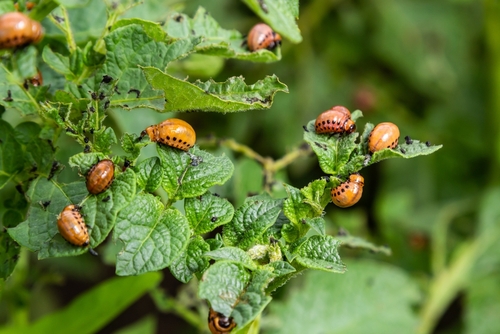
Beetles are another common pest that can cause white spots on potato leaves. The Colorado potato beetle is a notorious pest that can cause significant damage to potato crops. These beetles lay their eggs on the underside of potato leaves, and the larvae feed on the leaves, causing them to develop white spots and turn yellow.
3. Cutworms and Caterpillars
Cutworms and caterpillars are also known to cause white spots on potato leaves. These pests feed on the leaves and can cause significant damage to potato crops. Cutworms and caterpillars are the larvae of moths and butterflies, and they can be difficult to spot. They often hide during the day and feed at night.
4. Mites
Mites are tiny insects that can cause white spots on potato leaves. Spider mites are a common pest that can infest potato plants. These mites feed on the sap of the plant, causing the leaves to turn yellow and develop white spots. Spider mites are difficult to spot with the naked eye, but they can be seen with a magnifying glass.
Prevention and Treatment
1. Cultural Practices
Prevention is the best way to avoid white spots on potato leaves. Cultural practices such as crop rotation, clean up, and proper watering can help prevent the spread of disease.
Crop rotation is important because it helps break the disease cycle. Avoid planting potatoes in the same soil for more than two years. Clean up plant debris and weeds in the garden and surrounding areas to prevent the spread of disease.
Watering should be done in the morning, and overhead irrigation should be avoided. Mature plants should not be stressed by over or under watering.
2. Use of Fungicides and Insecticides
Fungicides and insecticides can be used to treat white spots on potato leaves. Fungicides should be used as a preventative measure before the disease appears.
Fungicides containing copper can be used to control early blight and late blight. Insecticides can be used to control insects that spread disease. Insecticidal soap and neem oil are effective natural options. Pheromone traps can be used to control moths that spread disease.
3. Natural Remedies

Natural remedies can be used to treat white spots on potato leaves. Diatomaceous earth can be used to control insects that spread disease. Hand-picking insects can be effective for small infestations.
Honeydew can be washed off with water. Plants can be stressed by cool weather, wind, and overwinter conditions, making them more susceptible to disease. Natural remedies should be used in conjunction with cultural practices and fungicides and insecticides.
By following these cultural practices and using fungicides and insecticides as needed, gardeners can prevent and treat white spots on potato leaves.
Impact on Potato Harvest
White spots on potato leaves can have a significant impact on the overall potato harvest. The disease can cause a reduction in yield and quality of potatoes, leading to financial losses for farmers. In this section, we will explore the effects of white spots on potato tubers and discuss how to harvest infected plants.
Effect on Potato Tubers
White spots on potato leaves can lead to a reduction in the size and number of potato tubers. This is because the disease can cause the foliage to die back prematurely, reducing the photosynthetic capacity of the plant.
As a result, the plant produces fewer carbohydrates, which are essential for the growth and development of potato tubers.
In addition, white spots on potato leaves can also make the potato tubers more vulnerable to other diseases and pests. The weakened plants are more susceptible to attack by pathogens such as late blight, which can cause significant damage to the crop.
Harvesting Infected Plants
Harvesting infected plants can be challenging, as the disease can spread rapidly from plant to plant. It is essential to remove infected leaves and stems as soon as possible to prevent the disease from spreading further.
Farmers should also avoid harvesting potatoes when the foliage is wet, as this can increase the risk of spreading the disease.
When harvesting infected plants, farmers should take care to avoid damaging the potato tubers. Rough handling can cause bruising and damage, which can make the potatoes more susceptible to rot and other diseases. It is also important to store harvested potatoes in a cool, dry place to prevent sprouting and decay.
Frequently Asked Questions
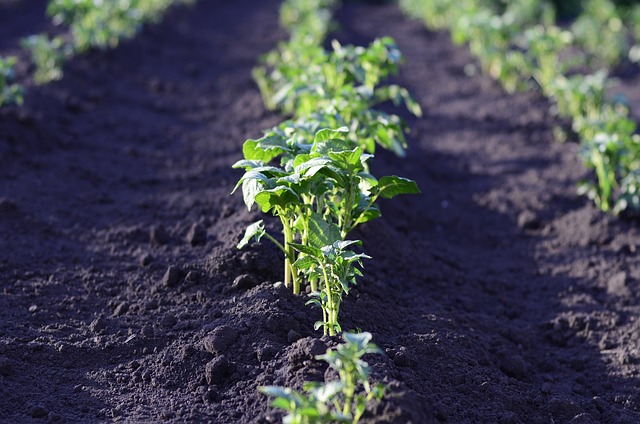
What causes discoloration on potato leaves?
Discoloration on potato leaves can be caused by a variety of factors, including disease, insect infestation, and environmental stressors such as drought or extreme temperatures.
Some common diseases that cause discoloration on potato leaves include early blight, late blight, and powdery mildew. Insect infestations, such as potato psyllids, can also cause discoloration on potato leaves.
Are white spots on potato leaves harmful?
White spots on potato leaves can be a sign of disease or insect infestation, which can harm the plant and reduce yield. However, not all white spots on potato leaves are harmful. Some white spots are simply a result of environmental stressors and do not indicate a serious problem.
What is the white powdery substance on my potato leaves?
The white powdery substance on potato leaves is likely powdery mildew, a common fungal disease that affects many plants, including potatoes.
Powdery mildew appears as a white or gray powdery coating on the leaves, stems, and flowers of infected plants. It can cause leaves to yellow and wilt, and reduce yield.
Can white spots on sweet potato leaves be treated?
White spots on sweet potato leaves can be treated using a variety of methods, depending on the cause of the spots. If the spots are caused by a disease, such as powdery mildew, a fungicide may be necessary to control the disease.
If the spots are caused by an insect infestation, such as whiteflies or spider mites, an insecticide may be necessary to control the insects.
How can I prevent white spots from forming on potato leaves?
Preventing white spots on potato leaves involves proper plant care and management. This includes planting disease-resistant varieties, rotating crops, and maintaining good soil health.
It is also important to monitor plants regularly for signs of disease or insect infestation and take action as soon as a problem is detected.
What is the disease affecting my potato plants?
The disease affecting potato plants can vary depending on the symptoms and location of the plant. Some common diseases that affect potato plants include early blight, late blight, and powdery mildew.
It is important to correctly identify the disease affecting your potato plants in order to properly treat and manage the problem.

Hey, I’m Lisa and I’ve been an avid gardener for over 30 years. I love writing, talking and living in the garden! Feel free to connect with me on my socials below

